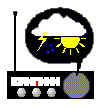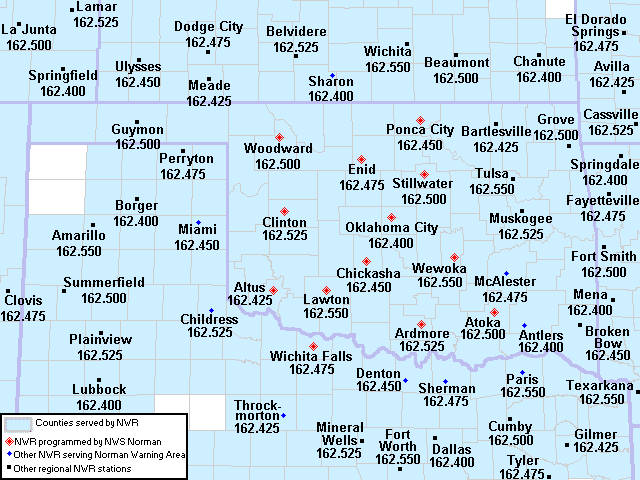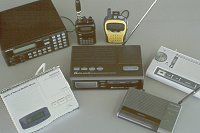 |
All Hazards Weather Radio |
|
Do you have questions or comments about weather radio? |
|
Weather Radio Broadcasts in the NWS Norman County Warning Area

Weather Radio Transmitters Programmed by NWS Norman:
- KJY94: Chickasha, OK - 162.450 MHz - Serving central Oklahoma, originating from NWS Norman, with a transmitter site near Chickasha, OK.
- KJY95: Wewoka, OK - 162.550 MHz - Serving southeastern Oklahoma, originating from NWS Norman, with a transmitter site near Wewoka, OK.
- KWN49: Atoka, OK - 162.500 MHz - Serving southeastern Oklahoma, originating from NWS Norman, with a transmitter site in Atoka, OK.
- KXI57: Ardmore, OK - 162.525 MHz - Serving south-central and southeastern Oklahoma, originating from NWS Norman, with a transmitter site near Davis, OK.
- WNG654: Stillwater, OK - 162.500 MHz - Serving central and north-central Oklahoma, originating from NWS Norman, with a transmitter site in Stillwater, OK.
- WXK85: Oklahoma City, OK - 162.400 MHz - Serving central Oklahoma, originating from NWS Norman, with a transmitter site in Oklahoma City, OK.
- WXK31: Wichita Falls, TX - 162.475 MHz - Serving western north Texas and southwestern Oklahoma, originating from NWS Norman, with a transmitter site in Wichita Falls, TX.
- WXK86: Lawton, OK - 162.550 MHz - Serving southwestern Oklahoma, originating from NWS Norman, with a transmitter site in Lawton, OK.
- WXK87: Clinton, OK - 162.525 MHz - Serving west-central Oklahoma, originating from NWS Norman, with a transmitter site near Arapahoe, OK.
- WXL48: Enid, OK - 162.475 MHz - Serving central and north-central Oklahoma, originating from NWS Norman, with a transmitter site near Drummond, OK.
- WWF42: Ponca City, OK - 162.450 MHz - Serving north-central Oklahoma and south-central Kansas, originating from NWS Norman, with a transmitter site in Ponca City, OK.
- WWG46: Woodward, OK - 162.500 MHz - Serving northwestern Oklahoma, originating from NWS Norman, with a transmitter site in Woodward, OK.
- WWG97: Altus, OK - 162.425 MHz - Serving southwestern Oklahoma and western north Texas, originating from NWS Norman, with a transmitter site in Altus, OK.
Weather Radio Transmitters Serving the NWS Norman Area Programmed by Other NWS Offices:
- WZ2511: Sharon, KS - 162.400 MHz - Serving the Gypsum Hills area in southern Kansas as well as parts of northwestern and north central Oklahoma, originating from NWS Wichita, with a transmitter site near Sharon, KS.
- KJY77: Antlers, OK - 162.400 MHz - Serving southeastern Oklahoma, originating from NWS Tulsa, with a transmitter site near Antlers, OK.
- KJY96: Guymon, OK - 162.500 MHz - Serving the Oklahoma and northern Texas Panhandles, originating from NWS Amarillo, with a transmitter site near Guymon, OK.
- WXL49: McAlester, OK - 162.475 MHz - Serving east-central and southeastern Oklahoma, originating from NWS Tulsa, with a transmitter site in McAlester, OK.
- KJY97: Childress, TX - 162.525 MHz - Serving the Texas Panhandle, western north Texas and southwestern Oklahoma, originating from NWS Lubbock, TX, with a transmitter site near Childress, TX.
- KHA99: Muenster, TX - 162.450 MHz - Serving north Texas, and south-central Oklahoma, originating from NWS Forth Worth, TX, with a transmitter site near Muenster, TX.
- WNG713: Miami, TX - 162.450 MHz - Serving the eastern Texas Panhandle, and west-central Oklahoma, originating from NWS Amarillo, TX, with a transmitter site near Miami, TX.
- WXK20: Paris, TX - 162.550 MHz - Serving north Texas, and southeastern Oklahoma, originating from NWS Forth Worth, TX, with a transmitter site in Paris, TX.
- WXK22: Sherman, TX - 162.475 MHz - Serving north Texas, and south-central/southeastern Oklahoma, originating from NWS Forth Worth, TX, with a transmitter site near Denison, TX.
- WNG722: Throckmorton, TX - 162.425 MHz - Serving west central and western north Texas, originating from NWS San Angelo, TX, with a transmitter site near Throckmorton, TX.
Weather Radio Overview
National Weather Service Weather Radio (NWR) is a service that broadcasts on seven VHF Band frequencies ranging from 162.400 MHz to 162.550 MHz. These frequencies are outside the normal AM or FM broadcast bands found on the average home radio.
These broadcasts originate from local National Weather Service (NWS) offices across the United States. As the Voice of the National Weather Service, weather radio provides continuous broadcasts of the latest weather information. Broadcasts can be heard as far away as 40 miles from the antenna site. However, the effective range depends on several factors, including the terrain, quality of the receiver, and current weather conditions.
NWS Weather Radio provides dependable and timely weather information at your fingertips. From day-to-day weather forecasts to warnings of deadly storms, NWR is always available, 24 hours a day, 365 days a year. The broadcast schedule consists of messages which are repeated every three to five minutes and are routinely revised to provide up-to-date information.
 During severe weather or other potentially hazardous events, the regularly scheduled programming is interrupted to substitute severe weather (including warnings, watches, etc.) or other hazardous informational messages. Special NWR receivers can be activated, sounding an alarm indicating that important information soon follows. Tests of the warning alarm are normally conducted by NWS Norman every Wednesday around 12:00 pm and 7:00 pm local time.
During severe weather or other potentially hazardous events, the regularly scheduled programming is interrupted to substitute severe weather (including warnings, watches, etc.) or other hazardous informational messages. Special NWR receivers can be activated, sounding an alarm indicating that important information soon follows. Tests of the warning alarm are normally conducted by NWS Norman every Wednesday around 12:00 pm and 7:00 pm local time.
NWR can also be used to alert you to non-weather related emergencies, such as earthquakes, toxic or chemical spills, national attacks, or nuclear blasts. Many local retailers or electronics stores sell NWS Weather Radios.
The National Weather Service encourages everyone to use weather radio to receive life-saving warnings and other information from the National Weather Service in Norman. The warning alarm precedes tornado and severe thunderstorm watches, and tornado, severe thunderstorm and flash flood warnings, as well as other emergency messages, and is designed to activate specially designed weather radio receivers, providing audible and/or visual warning signals to homes, schools and businesses in the path of the storm.
Normal Programming Schedule for Weather Radio Transmitters in NWS Norman's area.
- Local 7-Day Forecast - Valid For the NWS Weather Radio listening area.
- Hourly Weather Roundup - Summarizes current weather conditions for cities across Oklahoma, western north Texas, and surrounding regions.
- Climate Information - Includes temperatures and rainfall, climatological normals, and accumulations for Oklahoma City, Lawton, and Wichita Falls.
- Please see the "Cycle" tab for more information.
Other Programming Information As Needed
- Severe Weather Watches, Warnings, and Statements - Important information regarding the location and movements of severe thunderstorms, including damaging winds, large hail, and/or tornadoes.
- Flood/Flash Flood Watches, Warnings, and Statements - Important information regarding the location and movement of heavy rain and flash flood producing thunderstorms and weather systems.
- Winter Weather Watches, Warnings, and Advisories - Important information regarding potential hazardous winter weather.
- Non-Precipitation Warnings and Advisories - Important information regarding potentially hazardous weather conditions not associated with precipitation, such as wind chill, heat, non-thunderstorm high winds, fog, frost, and freezes.
Weather Radio Tests
The Norman Forecast Office conducts a weekly alert tests on Wednesdays. The weekly test is provided to allow radio owners to verify that their radios are functioning correctly. Some radios display a message, such as "Check Op," after they fail to receive the test. At NWS Norman, as with most NWS offices, the weekly weather radio test are conducted each Wednesday at noon and 7 pm. If there is a risk of severe weather around noon or 7 pm on Wednesday, the test is postponed until the next "good weather" day.
It is not unusual for radios located near the edge of the reliable broadcast area to fail to receive the test occasionally. However, if this occurs repeatedly, you should attempt to improve the radio's reception, either by relocating the radio, adjusting its antenna, or adding an external antenna. In a few cases, this situation may be helped by tuning to a different transmitter.
Specific Area Message Encoder (SAME)
New technology is now available in NWS Weather Radio that allows you to obtain only the warnings, watches, and other information you want.
This technology, called the Specific Area Message Encoder (SAME), broadcasts the same information we always have had, but adds a code that enables specially built receivers to receive only the information the you want. Thus, you can receive severe weather warnings, watches, and statements for the only county in which you live, if desired, and not information for other counties in the overall NWR broadcast area.
All current and older model NWR receivers will receive all information from the NWS, but only radios with the SAME capability can be programmed to receive only information for specific counties.
Since the SAME codes are fully compatible with the FCC's Emergency Alert System, it is possible in the future that new television sets, pagers, cellular telephones and other electronic devices will be able to receive these SAME coded messages.
These new receivers are available at local electronics stores in your area. If you have purchased a new weather radio with the SAME capability and want to program it for specific counties in your NWR listening area, you will need the proper county codes (FIPS). Please see the "Codes" tab for more information. Also included is a listing of event codes used by the National Weather Service to designate specific weather events.


